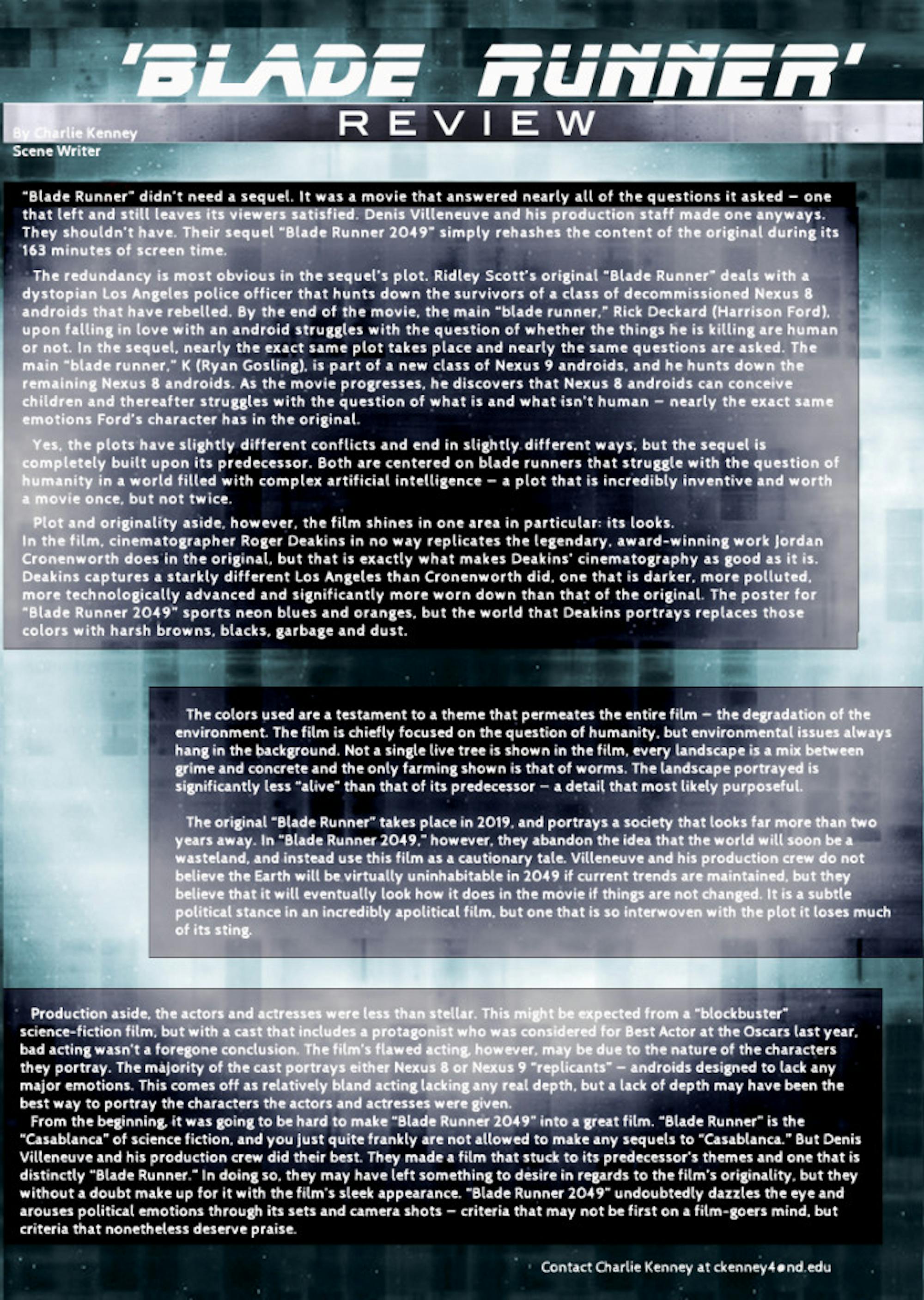
“Blade Runner” didn’t need a sequel. It was a movie that answered nearly all of the questions it asked — one that left and still leaves its viewers satisfied. Denis Villeneuve and his production staff made one anyways.
They shouldn’t have. Their sequel “Blade Runner 2049” simply rehashes the content of the original during its 163 minutes of screen time.
The redundancy is most obvious in the sequel’s plot. Ridley Scott’s original “Blade Runner” deals with a dystopian Los Angeles police officer that hunts down the survivors of a class of decommissioned Nexus 8 androids that have rebelled. By the end of the movie, the main “blade runner,” Rick Deckard (Harrison Ford), upon falling in love with an android struggles with the question of whether the things he is killing are human or not. In the sequel, nearly the exact same plot takes place and nearly the same questions are asked. The main “blade runner,” K (Ryan Gosling), is part of a new class of Nexus 9 androids, and he hunts down the remaining Nexus 8 androids. As the movie progresses, he discovers that Nexus 8 androids can conceive children and thereafter struggles with the question of what is and what isn’t human — nearly the exact same emotions Ford’s character has in the original.
Yes, the plots have slightly different conflicts and end in slightly different ways, but the sequel is completely built upon its predecessor. Both are centered on blade runners that struggle with the question of humanity in a world filled with complex artificial intelligence — a plot that is incredibly inventive and worth a movie once, but not twice.
Plot and originality aside, however, the film shines in one area in particular: its looks.
In the film, cinematographer Roger Deakins in no way replicates the legendary, award-winning work Jordan Cronenworth does in the original, but that is exactly what makes Deakins’ cinematography as good as it is. Deakins captures a starkly different Los Angeles than Cronenworth did, one that is darker, more polluted, more technologically advanced and significantly more worn down than that of the original. The poster for “Blade Runner 2049” sports neon blues and oranges, but the world that Deakins portrays replaces those colors with harsh browns, blacks, garbage and dust.
The colors used are a testament to a theme that permeates the entire film — the degradation of the environment. The film is chiefly focused on the question of humanity, but environmental issues always hang in the background. Not a single live tree is shown in the film, every landscape is a mix between grime and concrete and the only farming shown is that of worms. The landscape portrayed is significantly less “alive” than that of its predecessor — a detail that most likely purposeful.
The original “Blade Runner” takes place in 2019, and portrays a society that looks far more than two years away. In “Blade Runner 2049,” however, they abandon the idea that the world will soon be a wasteland, and instead use this film as a cautionary tale. Villeneuve and his production crew do not believe the Earth will be virtually uninhabitable in 2049 if current trends are maintained, but they believe that it will eventually look how it does in the movie if things are not changed. It is a subtle political stance in an incredibly apolitical film, but one that is so interwoven with the plot it loses much of its sting.
Production aside, the actors and actresses were less than stellar. This might be expected from a “blockbuster” science-fiction film, but with a cast that includes a protagonist who was considered for Best Actor at the Oscars last year, bad acting wasn’t a foregone conclusion. The film’s flawed acting, however, may be due to the nature of the characters they portray. The majority of the cast portrays either Nexus 8 or Nexus 9 “replicants” — androids designed to lack any major emotions. This comes off as relatively bland acting lacking any real depth, but a lack of depth may have been the best way to portray the characters the actors and actresses were given.
From the beginning, it was going to be hard to make “Blade Runner 2049” into a great film. “Blade Runner” is the “Casablanca” of science fiction, and you just quite frankly are not allowed to make any sequels to “Casablanca.” But Denis Villeneuve and his production crew did their best. They made a film that stuck to its predecessor’s themes and one that is distinctly “Blade Runner.” In doing so, they may have left something to desire in regards to the film’s originality, but they without a doubt make up for it with the film’s sleek appearance. “Blade Runner 2049” undoubtedly dazzles the eye and arouses political emotions through its sets and camera shots — criteria that may not be first on a film-goers mind, but criteria that nonetheless deserve praise.
Read More
Trending









